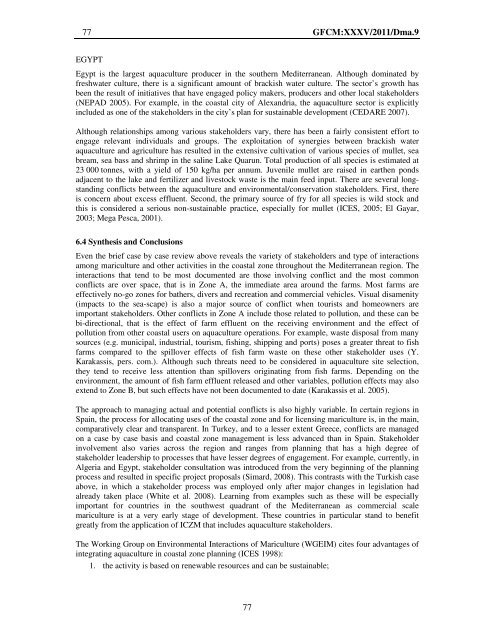Site selection and carrying capacity in Mediterranean ... - FAO Sipam
Site selection and carrying capacity in Mediterranean ... - FAO Sipam
Site selection and carrying capacity in Mediterranean ... - FAO Sipam
Create successful ePaper yourself
Turn your PDF publications into a flip-book with our unique Google optimized e-Paper software.
77 GFCM:XXXV/2011/Dma.9<br />
EGYPT<br />
Egypt is the largest aquaculture producer <strong>in</strong> the southern <strong>Mediterranean</strong>. Although dom<strong>in</strong>ated by<br />
freshwater culture, there is a significant amount of brackish water culture. The sector’s growth has<br />
been the result of <strong>in</strong>itiatives that have engaged policy makers, producers <strong>and</strong> other local stakeholders<br />
(NEPAD 2005). For example, <strong>in</strong> the coastal city of Alex<strong>and</strong>ria, the aquaculture sector is explicitly<br />
<strong>in</strong>cluded as one of the stakeholders <strong>in</strong> the city’s plan for susta<strong>in</strong>able development (CEDARE 2007).<br />
Although relationships among various stakeholders vary, there has been a fairly consistent effort to<br />
engage relevant <strong>in</strong>dividuals <strong>and</strong> groups. The exploitation of synergies between brackish water<br />
aquaculture <strong>and</strong> agriculture has resulted <strong>in</strong> the extensive cultivation of various species of mullet, sea<br />
bream, sea bass <strong>and</strong> shrimp <strong>in</strong> the sal<strong>in</strong>e Lake Quarun. Total production of all species is estimated at<br />
23 000 tonnes, with a yield of 150 kg/ha per annum. Juvenile mullet are raised <strong>in</strong> earthen ponds<br />
adjacent to the lake <strong>and</strong> fertilizer <strong>and</strong> livestock waste is the ma<strong>in</strong> feed <strong>in</strong>put. There are several longst<strong>and</strong><strong>in</strong>g<br />
conflicts between the aquaculture <strong>and</strong> environmental/conservation stakeholders. First, there<br />
is concern about excess effluent. Second, the primary source of fry for all species is wild stock <strong>and</strong><br />
this is considered a serious non-susta<strong>in</strong>able practice, especially for mullet (ICES, 2005; El Gayar,<br />
2003; Mega Pesca, 2001).<br />
6.4 Synthesis <strong>and</strong> Conclusions<br />
Even the brief case by case review above reveals the variety of stakeholders <strong>and</strong> type of <strong>in</strong>teractions<br />
among mariculture <strong>and</strong> other activities <strong>in</strong> the coastal zone throughout the <strong>Mediterranean</strong> region. The<br />
<strong>in</strong>teractions that tend to be most documented are those <strong>in</strong>volv<strong>in</strong>g conflict <strong>and</strong> the most common<br />
conflicts are over space, that is <strong>in</strong> Zone A, the immediate area around the farms. Most farms are<br />
effectively no-go zones for bathers, divers <strong>and</strong> recreation <strong>and</strong> commercial vehicles. Visual disamenity<br />
(impacts to the sea-scape) is also a major source of conflict when tourists <strong>and</strong> homeowners are<br />
important stakeholders. Other conflicts <strong>in</strong> Zone A <strong>in</strong>clude those related to pollution, <strong>and</strong> these can be<br />
bi-directional, that is the effect of farm effluent on the receiv<strong>in</strong>g environment <strong>and</strong> the effect of<br />
pollution from other coastal users on aquaculture operations. For example, waste disposal from many<br />
sources (e.g. municipal, <strong>in</strong>dustrial, tourism, fish<strong>in</strong>g, shipp<strong>in</strong>g <strong>and</strong> ports) poses a greater threat to fish<br />
farms compared to the spillover effects of fish farm waste on these other stakeholder uses (Y.<br />
Karakassis, pers. com.). Although such threats need to be considered <strong>in</strong> aquaculture site <strong>selection</strong>,<br />
they tend to receive less attention than spillovers orig<strong>in</strong>at<strong>in</strong>g from fish farms. Depend<strong>in</strong>g on the<br />
environment, the amount of fish farm effluent released <strong>and</strong> other variables, pollution effects may also<br />
extend to Zone B, but such effects have not been documented to date (Karakassis et al. 2005).<br />
The approach to manag<strong>in</strong>g actual <strong>and</strong> potential conflicts is also highly variable. In certa<strong>in</strong> regions <strong>in</strong><br />
Spa<strong>in</strong>, the process for allocat<strong>in</strong>g uses of the coastal zone <strong>and</strong> for licens<strong>in</strong>g mariculture is, <strong>in</strong> the ma<strong>in</strong>,<br />
comparatively clear <strong>and</strong> transparent. In Turkey, <strong>and</strong> to a lesser extent Greece, conflicts are managed<br />
on a case by case basis <strong>and</strong> coastal zone management is less advanced than <strong>in</strong> Spa<strong>in</strong>. Stakeholder<br />
<strong>in</strong>volvement also varies across the region <strong>and</strong> ranges from plann<strong>in</strong>g that has a high degree of<br />
stakeholder leadership to processes that have lesser degrees of engagement. For example, currently, <strong>in</strong><br />
Algeria <strong>and</strong> Egypt, stakeholder consultation was <strong>in</strong>troduced from the very beg<strong>in</strong>n<strong>in</strong>g of the plann<strong>in</strong>g<br />
process <strong>and</strong> resulted <strong>in</strong> specific project proposals (Simard, 2008). This contrasts with the Turkish case<br />
above, <strong>in</strong> which a stakeholder process was employed only after major changes <strong>in</strong> legislation had<br />
already taken place (White et al. 2008). Learn<strong>in</strong>g from examples such as these will be especially<br />
important for countries <strong>in</strong> the southwest quadrant of the <strong>Mediterranean</strong> as commercial scale<br />
mariculture is at a very early stage of development. These countries <strong>in</strong> particular st<strong>and</strong> to benefit<br />
greatly from the application of ICZM that <strong>in</strong>cludes aquaculture stakeholders.<br />
The Work<strong>in</strong>g Group on Environmental Interactions of Mariculture (WGEIM) cites four advantages of<br />
<strong>in</strong>tegrat<strong>in</strong>g aquaculture <strong>in</strong> coastal zone plann<strong>in</strong>g (ICES 1998):<br />
1. the activity is based on renewable resources <strong>and</strong> can be susta<strong>in</strong>able;<br />
77
















